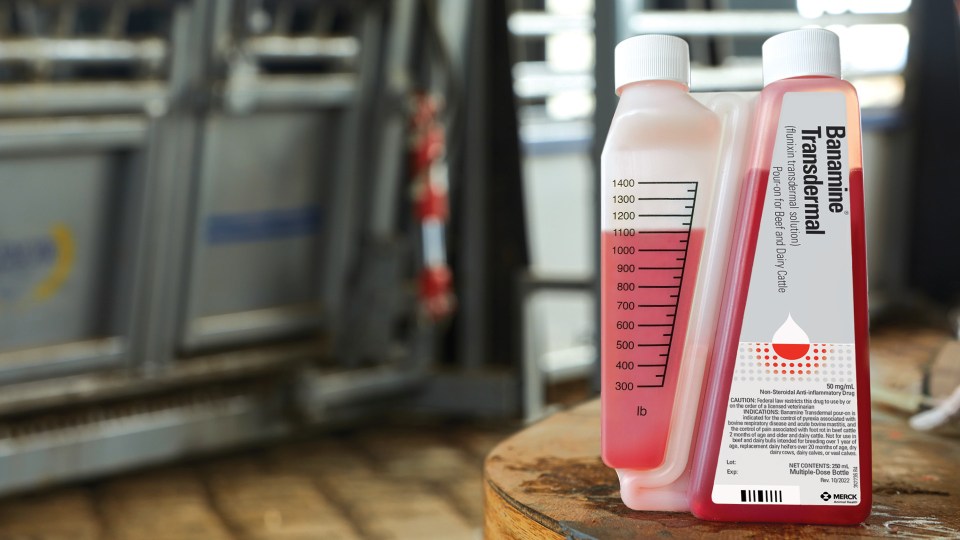FAQs: BANAMINE® TRANSDERMAL (flunixin transdermal solution)
Producers across the country are excited about a new option to mitigate pain and fever in dairy cows. BANAMINE® TRANSDERMAL (flunixin transdermal solution) is FDA-approved for control of fever associated with bovine respiratory disease and acute mastitis, and for control of pain associated with foot rot. BANAMINE TRANSDERMAL is the only non-steroidal, anti-inflammatory drug (NSAID) available as a convenient pour-on for cattle.
For dairy producers who want to know more about BANAMINE TRANSDERMAL, here’s a list of commonly asked questions and their answers.
How can this product make my life easier?

As a pour-on product, BANAMINE TRANSDERMAL takes only a few seconds to administer — saving time, labor and equipment needed to give an IV. Quick and easy administration is less stressful and frees up workers for other important tasks.
Why use an NSAID?
Pain and fever can cause cattle to go off feed and not perform their best. Caregivers can see visible results from relieving pain and fever symptoms in cattle, supporting recovery and getting cows back into the milking string faster.
Will the product work if herd mates lick the product after it’s been applied?
There is no need to adjust the dose of BANAMINE TRANSDERMAL to account for the effect of licking.
How do I know I’m pouring on the right amount?
Pre-calibrated packaging makes it easy to measure the correct dose volume (3mL per 100 lbs body weight) and apply along the back from withers to tailhead. The red solution verifies administration, so you can be confident it’s been applied correctly.
Does BANAMINE TRANSDERMAL work in cold weather?
The effect of temperature on product absorption was tested under a variety of environmental conditions and in air temperatures ranging from 15.1-20.1 F (average low in the coldest location) to 80-100 F (average high in the warmest location).1 There is no need to adjust dosing due to hot or cold weather.
Does exposure to rain or misters affect efficacy?
Effectiveness has not been measured under wet hide conditions. It’s best to avoid treating cows with wet hides. After treatment on dry skin, protect cows from rain and/or keep them away from misters for six hours.
Is there a milk withhold?
BANAMINE TRANSDERMAL requires a short, 48-hour milk withhold after treatment. Ask your local veterinarian about the first and only pour-on NSAID that’s FDA approved for pain and fever relief in cattle — now approved to control fever due to acute mastitis in dairy cows. To learn more, contact your Merck Animal Health representative or visit BanamineTD.com.
IMPORTANT SAFETY INFORMATION:
IMPORTANT SAFETY INFORMATION: NOT FOR HUMAN USE. KEEP OUT OF REACH OF CHILDREN. Milk that has been taken during treatment and for 48 hours after treatment must not be used for human consumption. Cattle must not be slaughtered for human consumption within 8 days of the last treatment. Not for use in replacement dairy heifers 20 months of age or older or dry dairy cows; use in these cattle may cause drug residues in milk and/or calves born to these cows or heifers. Not for use in beef and dairy bulls intended for breeding over 1 year of age, beef calves less than 2 months of age, dairy calves, and veal calves. Do not use within 48 hours of expected parturition. Approved only as a single topical dose in cattle. For complete information on BANAMINE® TRANSDERMAL, see accompanying product package insert.
References
- Product label.
Find more content for your dairy operation.
